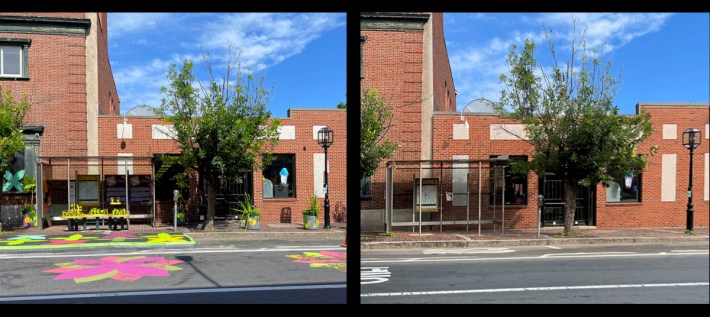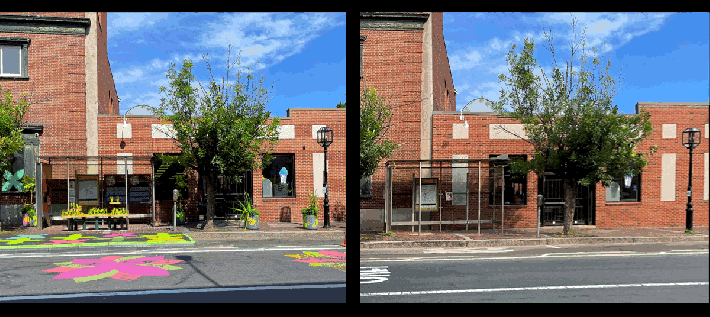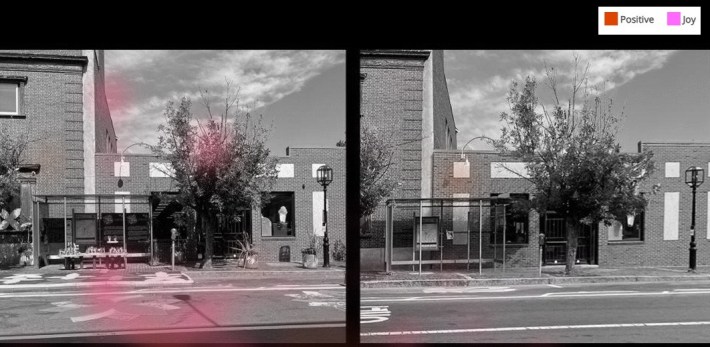Guest Column: With Data, We Can Design Bus Stops to Make People Feel Happy
When you hear about a space designed to be accessible that has an oasis of felt plants, potted 20-foot-tall trees, and stenciled flowers, a bus stop is probably not the first thing that comes to mind.
Yet, that’s what bus riders in the City of Chelsea have experienced over the last couple of months with the remarkable transformation of a bus shelter on Broadway serving the lines 114 and 116 (pictured above).
To infuse the bus experience for riders with a little bit of joy, the City of Chelsea, in collaboration with the Boston Bus Rapid Transit (BostonBRT) initiative, created the “Flower Walk” art installation at the Broadway and 3rd Street bus stop. Beyond a revamped bus stop with over 180 plantings, colorful aesthetic designs, and immersive art elements created by several local artists and youth groups, the project featured a new level-boarding bus (ZICLA) platform that allows riders to board safely without having to step off the curb in an area with heavy traffic.
The project also sought to understand – with data – how improved bus stops shape how people interact with the natural and built environment. In other words, can better bus stops make everyone near them happier, whether or not you ride the bus?
Urban design and transit planning throughout the 20th century often ignored the human experience, resulting in cityscapes and urban environments (e.g., wide highways and long stretches of concrete sidewalks) that pose mobility challenges and make street spaces feel unwelcoming. However, biometric technologies used in the car manufacturing industry, including eye-tracking software, can help cities and towns promote human-centered designs and guide the development of infrastructure that meets people’s needs.
We at the Human Architecture and Planning Institute (theHapi.org) leveraged these technologies with the Chelsea “Flower Walk” to show how nonconscious behaviors direct our experience in urban environments far more than most realize. We conducted a study using biometric softwares from iMotions.com, a global purveyor of biometrics tools for human behavioral research. Survey participants looked at before and after photos of the transformed bus stop in Chelsea for twelve seconds on their laptops or computers and webcams running iMotions-online.

We first wanted to understand how people look at a bus stop. What catches their eye? The data showed that the original bus stop did not attract passersby’s attention and that adding color and artistic elements, along with small infrastructural changes, to roadways and bus stops caught people’s attention and that this can change human perception.
The diptych of photos above displays the original bus stop and an image of its redesign with colorful flower art. The figure below shows how viewers reacted to this image:

This heatmap shows participants’ attention glowing reddest where they looked most – on and around the revamped bus bench with felt flowers. It fades to yellow and green around the colorful flower patterns at its base, where attention starts to decrease, with no comparable focal point and attention drawn anywhere at the original bus stop that lacks both the bench and the flower art elements.
We also wanted to show how the bus stop not only draws people’s attention to essential elements of the bus stop, like the revamped bench, bright signage, and colorful boarding platform – but that it makes them feel happy. iMotions and the emotional expression software Affectiva helped with that.
The emotional heatmap below shows how color washes over the bus stop image, indicating participants’ emotional experience at a glance. It shows how joyful feelings (see the pink color wash on the left) surround the transformed bus stop and positive emotions around the flowery walk. There are no strong emotions over the image of the original bus stop (seen on the right).

Beyond understanding how artistic and infrastructural improvements can enhance people’s bus experience, these technologies suggest a path forward for future research that looks beyond the bus but at street design more generally and an opportunity to acknowledge human perceptual biology and biases.
For urban planners, the Chelsea “Flower Walk” bus stop initiative highlights many lessons to consider in the planning process, including:
- Define and incorporate goals for how people will experience infrastructural developments and improvements – easier to see and engage with, evoke feelings of joy, visually appealing and accessible, and more.
- Get creative in incorporating artistic and natural elements as well as embrace color – many people enjoyed the new bench with colorful felt flowers and the flower paintings along the street.
- Adopt biometrics technologies, surveys, and other measurement forms during the design process, with perspective drawings and renderings, to help achieve the goal of drawing people’s attention to critical elements of the space – including seating/benches, crosswalks, level-boarding platforms or other accessibility features, and more.
Ultimately, to plan for and develop bus stops and spaces centered around how people experience them is to improve our cities and towns with better buses and more connected natural and built environments that draw attention and spark joy.
The authors would like to thank AdHoc Industries, BostonBRT, transportation advocates, community partners, and artists, including La Colaborativa, Studioful Design, the Human Architecture and Planning Institute (the HAPI), several local artists, and the City of Chelsea‘s Department of Public Works for making the “Flower Walk” possible.
Ann Sussman, RA, is the President of The Human Architecture and Planning Institute, Inc (theHapi).
The post Guest Column: With Data, We Can Design Bus Stops to Make People Feel Happy appeared first on Streetsblog Massachusetts.
source https://mass.streetsblog.org/2023/12/27/guest-column-with-data-we-can-design-bus-stops-to-make-people-feel-happy

Comments
Post a Comment